TC
Auto Added by WPeMatico
Auto Added by WPeMatico
Honeywell, which only recently announced its entry into the quantum computing race, and Cambridge Quantum Computing (CQ), which focuses on building software for quantum computers, today announced that they are combining Honeywell’s Quantum Solutions (HQS) business with Cambridge Quantum in the form of a new joint venture.
Honeywell has long partnered with CQ, and invested in the company last year, too. The idea here is to combine Honeywell’s hardware expertise with CQ’s software focus to build what the two companies call “the world’s highest-performing quantum computer and a full suite of quantum software, including the first and most advanced quantum operating system.”
The merged companies (or “combination,” as the companies’ press releases calls it) expect the deal to be completed in the third quarter of 2021. Honeywell Chairman and CEO Darius Adamczyk will become the chairman of the new company. CQ founder and CEO Ilyas Khan will become the CEO and current Honeywell Quantum Solutions President Tony Uttley will remain in this role at the new company.
The idea here is for Honeywell to spin off HQS and combine it with CQC to form a new company, while still playing a role in its leadership and finances. Honeywell will own a majority stake in the new company and invest between $270 and $300 million. It will also have a long-term agreement with the new company to build the ion traps at the core of its quantum hardware. CQ’s shareholders will own 45% of the new company.
“The new company will have the best talent in the industry, the world’s highest-performing quantum computer, the first and most advanced quantum operating system, and comprehensive, hardware-agnostic software that will drive the future of the quantum computing industry,” said Adamczyk. “The new company will be extremely well positioned to create value in the near-term within the quantum computing industry by offering the critical global infrastructure needed to support the sector’s explosive growth.”
The companies argue that a successful quantum business will need to be supported by large-scale investments and offer a one-stop shop for customers that combines hardware and software. By combining the two companies now, they note, they’ll be able to build on their respective leadership positions in their areas of expertise and scale their businesses while also accelerate their R&D and product roadmaps.
“Since we first announced Honeywell’s quantum business in 2018, we have heard from many investors who have been eager to invest directly in our leading technologies at the forefront of this exciting and dynamic industry — now, they will be able to do so,” Adamczyk said. “The new company will provide the best avenue for us to onboard new, diverse sources of capital at scale that will help drive rapid growth.”
CQ launched in 2014 and now has about 150 employees. The company raised a total of $72.8 million, including a $45 million round, which it announced last December. Honeywell, IBM Ventures, JSR Corporation, Serendipity Capital, Alvarium Investments and Talipot Holdings invested in this last round — which also means that IBM, which uses a different technology but, in many ways, directly competes with the new company, now owns a (small) part of it.
Powered by WPeMatico
When it comes to sustainable livestock production and agriculture, measurement is the first — and sometimes most elusive — step in the process of turning our food system from a carbon emitter into a carbon sink.
So DSM, a science-based company that focuses on agriculture and other parts of our food systems, and Blonk, a data analytics for sustainability consultancy, developed Sustell, a combination software and practical service for ranchers to understand and improve the sustainability of their operations.
While sustainable and regenerative agriculture doesn’t have a universally agreed-upon definition, it usually involves changing land management practices to sequester more carbon in the soil, using more environmentally friendly animal feeds and reducing fossil fuel usage of tractors and other farm equipment among many other changes. The goal is to reduce the 7.1 gigatonnes of CO2 released into the atmosphere, about 14.5% of all greenhouse gas emissions, created by the livestock industry.
“There’s this tremendous need for accurate footprinting of animal production down to the individual farm level,” said David Nickell, vice president of sustainability and business solutions at DSM. “And each farm, of course, is very different. And you have to have a system which is able to use actual farm data, and to get an accurate picture of that particular farm.”
The system analyzes the environmental impact of a farm’s activity on 19 different categories, including climate change, resource use, water scarcity, runoff and ozone depletion. Farmers provide data on their daily operations, including feed composition and use, manure management practices, animal mortality, the electricity system and the other infrastructure, transportation logistics and mitigation technologies employed, like scrubbers or excess heat circulation systems, and sometimes packaging to the software.
Blonk’s environmental footprint technology then produces a life cycle assessment of the farm, an analysis of the environmental impact of rearing an animal from inception to when it exits the farm gate. DSM and Blonk have created Sustell modules for most land farm animals, including chickens, pigs and dairy and egg production, and plans to extend it to cover beef and aquaculture.
“What is really key is that we were able to build on this momentum of methodologies and standards that have been developed,” said Hans Blonk, CEO of Blonk Consultants and Blonk Sustainability Tools.
Blonk was able to combine agriculture environmental standards from the Food and Agriculture Organization of the United Nations, European Commission and many others in one place to create the vast library of background data needed for the software to produce useful and actionable insights.
“Customers at the moment really want to understand what they’re doing,” Nickell said. “They want to understand their baseline [footprint] and rank them. Understand what’s good, and what’s not so good. Customers want to understand how they rate compared to peer benchmarking, whether it’s a country or an industry benchmark.”
Once the Sustell software gives farmers clarity on the emissions on their farms, they can then identify where improvements need to be made and DSM helps implement ways of reducing those emissions, creating an end-to-end service for customers and hopefully a positive impact on the planet.
“Practical interventions make change happen,” Nickell said. “We’ve invested in technologies which reduce the footprint of animal products production. The service is measurement and marry that up with bringing solutions, which make a difference. That’s the complete solution to making this much-needed change happen.”
But in order for Sustell to create that change, it needs to be adopted widely and the learnings need to be shared between competitors. Right now, DSM and, in some ways, the capitalist system, isn’t set up for that.
According to Nickell, DSM is first focusing Sustell on big integrated livestock companies. This is a common challenge with new innovative environmental technologies that can be adopted by big farming conglomerates or co-ops with money and resources to spend, while smaller family farms get left behind. But Nickell hopes that Sustell can scale to work with smaller farms, as well.
The second issue is around data sharing. While Nickell was very clear that Sustell will be following all applicable data privacy and ownership rules — and that’s usually a good thing — in order to really create meaningful environmental change, transparency is actually key. Competitors need to share the best ways for reducing emissions so everyone can adopt them and save the planet, but many companies are very data protective.
“I think maybe that [data sharing] develops in time,” Nickell said. “I don’t think we’re there yet. Maybe it will get to that level as more and more customers are transparent on their footprint and their reporting.”
Powered by WPeMatico
TechCrunch Early Stage Part Two is set to take place July 8th and 9th. You can still shoot your shot to pitch to an amazing panel of judges and thousands of TC viewers. TechCrunch editors will select 10 founders from around the world to pitch on stage July 9th. Apply here.
Startups will have five minutes to pitch their companies, business models and innovative ideas — followed by a Q&A with our superb panel of judges. The winner will get a feature article on TechCrunch.com, one-year free subscription to Extra Crunch and a complimentary Founder Pass to TechCrunch Disrupt this fall.
TechCrunch Early Stage Part Two is set to be a game-changer for founders looking to take their startups to the next level. At this two-day virtual event, early-stage founders can take part in highly interactive group sessions with top investors and ecosystem experts, in fields ranging from fundraising and marketplace positioning, to growth marketing and content development.
Without further ado, here are your judges for the Early Stage Pitch-Off:
Ben Sun, Primary Venture Partners

Image Credits: Primary Venture Partners
Ben is a co-founder and general partner at Primary Venture Partners. He has been a serial entrepreneur and investor as a co-founder of LaunchTime, an incubator and investor in early-stage tech startups and as a co-founder of Community Connect, which was one of the first social networking companies. Ben focuses his investing activities on primarily consumer-facing companies. His previous investments include Coupang, Jet.com, MakeSpace, Ollie, Mirror, Slice, Bounce Exchange, Selfmade, Shoptalk and Penrose Hill. Ben has been active in the NYC tech community for almost 20 years. Prior to working as an entrepreneur and investor, Ben worked at Merrill Lynch in the Technology Investment Banking Group. He graduated from the University of Michigan with a degree in Economics.
Leah Solivan, Fuel Capital

Image Credits: Leah Solivan
Leah Solivan is general partner at Fuel Capital, where she invests in early-stage companies across consumer technology, hardware, marketplaces and retail. She’s passionate about supporting teams who are taking on world-changing ideas. Leah relates so well to founders because she is one herself. She created one of the most widely recognized consumer brands of the past decade with TaskRabbit. As TaskRabbit’s CEO for eight years, Leah scaled the company to 44 cities and raised more than $50 million. In 2016, Leah transitioned into the role of executive chairwoman and in 2017, TaskRabbit was acquired by IKEA.
Shardul Shah, Index Ventures

Image Credits: Index Ventures
Shardul joined Index in 2008. He focuses on security, cloud infrastructure and enterprise software investments. He is a director of Attack IQ, Brightback, Castle Intelligence, Datadog (Nasdaq:DDOG), Expel, Gatsby and Wiz.io. Shardul was previously a director of Adallom (Microsoft), SourceClear (CA Technologies), Koality (Docker), Lacoon (Check Point), Base (Zendesk) and an investor in Duo Security (Cisco). After graduating from the University of Chicago, Shardul worked with Summit Partners where he focused on healthcare and internet technologies.
Powered by WPeMatico
Paytm, India’s most valuable startup, confirmed to its shareholders and employees on Monday that it plans to file for an IPO.
In a letter to shareholders and employees, Paytm said that it plans to raise money by issuing fresh equity in the IPO, and also sell existing shareholders’ shares at the event. The startup has offered its employees the option to sell their stakes in the firm.
This is the first time the Noida-headquartered firm, which is valued at $16 billion and has raised over $3 billion to date, has commented on its plans about the IPO. The startup said in the letter that it has received an in-principle approval from the board of directors to pursue the public market.
Paytm, which is backed by Alibaba and SoftBank, hasn’t shared when it plans to file for the IPO, but has sought shareholders’ response to their intention to sell stakes by the end of the month.
Two sources familiar with the matter told TechCrunch that Paytm plans to raise about $3 billion and is targeting a valuation of up to $30 billion in the IPO. Paytm declined to comment.
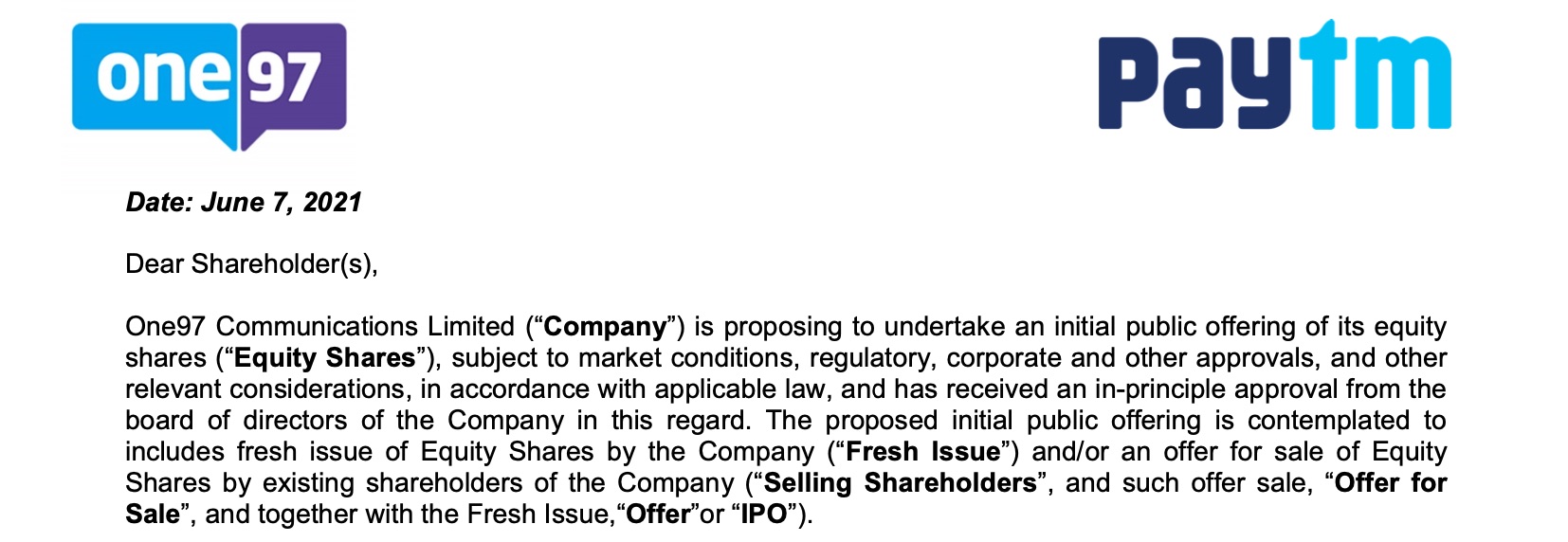
Paytm’s letter — obtained by TechCrunch — to shareholders on Monday.
This isn’t the first time Paytm has planned to explore the public route. Exactly 10 years ago, long before Paytm established itself as the largest mobile wallet firm and expanded to several financial and commerce services, the startup had filed with the regulator with intentions to become public. The startup at the time cancelled the IPO plan and instead raised money from VCs to explore new avenues for growth.
A lot is riding on a successful IPO of Paytm — which reported a consolidated loss of $233.6 million for the financial year that ended in March this year, down from $404 million a year ago. (The startup’s revenue fell 10% during this period to $437.6 million.) India’s stock markets are yet to be fully tested for tech startups’ stocks in the country — though retail investors have shown good signs in recent years.
The startup, which competes with Google Pay and Flipkart-backed PhonePe, has realigned its payments strategy in recent years to assume a leadership position in the merchant payments market.
In a report to its clients late last month, analysts at Bernstein said the startup’s credit tech vertical is likely to lead the next wave of its revenue growth.
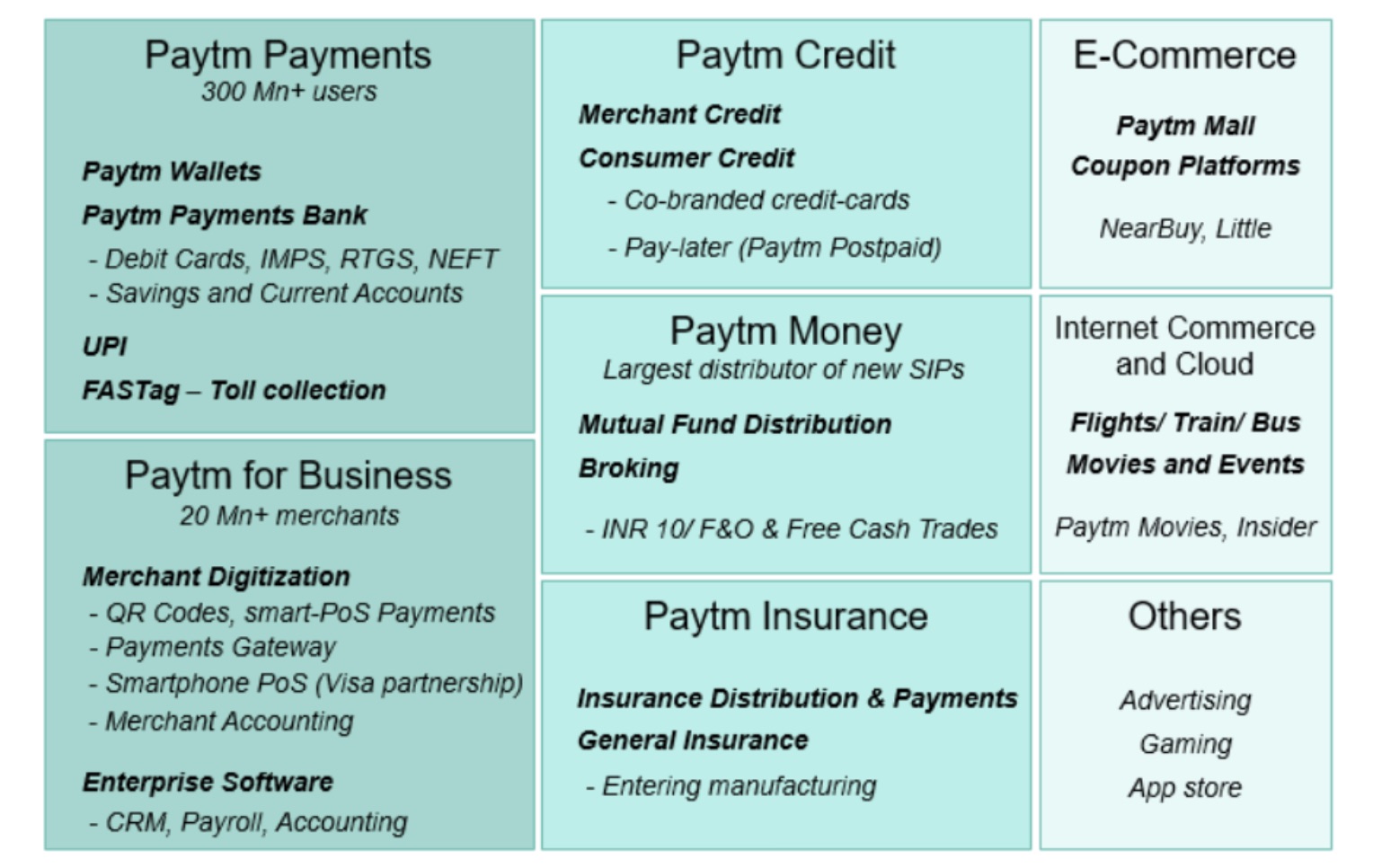
An overview of Paytm’s financial services ecosystem (Bernstein)
“With the advent of UPI, there has been a rising narrative that questioned Paytm’s market leadership,” the analysts wrote, referring to the exponential growth of payments stack developed by retail banks in India that has been adopted by several firms, including Google and PhonePe (as well as Paytm), and which has somewhat lowered the appeal of mobile wallets in India.
“However, under the hood, Paytm leads on merchant payments and has built an ecosystem of synergistic fintech verticals around its ‘super-app.’ The ecosystem spans payments (wallet/UPI), full-suite merchant acquiring, credit tech, digital bank, wealth, and insurance tech. We believe the super-app battle in India is not a ‘winner takes all’ but a game of execution, business building, and creating a superior customer experience with ecosystem integration,” Bernstein analysts added.
Paytm is the latest Indian giant startup that has expressed an interest in becoming public in recent months. Earlier this year, food delivery startup Zomato said it plans to raise $1.1 billion through an initial public offering. TechCrunch reported last month that Flipkart was in talks to raise over $1 billion in what is expected to be its financial fundraise ahead of an IPO.
Powered by WPeMatico
Welcome back to the week, and welcome back to The Exchange. Robinhood has yet to file its IPO, so we’re looking at other companies in the meantime. Today it’s Babylon Health, a British health tech company that is pursuing a U.S. listing via a blank-check company, or SPAC.
You have questions. I have questions. We’ll get to some answers.
But before we do, we wanted to note that Anna and I are looking into the AI startup market tomorrow morning. If you are a VC with notes regarding the current pace of investment into the sector or thoughts on where customer traction is highest, let us know. If you are a founder building an AI-powered startup, we’d also like to hear from you about what you are seeing. Use the subject line “AI startups,” please.
The Exchange explores startups, markets and money.
Read it every morning on Extra Crunch or get The Exchange newsletter every Saturday.
With that out of the way, let’s get into Babylon Health. We’ll kick off with a short riff on its fundraising history, talk about its product, and then dive into its numbers and, bracing ourselves for impact, its projections.
The larger context this morning is that we’re doing legwork ahead of what could be a super active Q3 2021 IPO cycle. Kanzhun, a Chinese company, has also filed for a U.S. listing. Toss in Robinhood whenever it gets off its duff and gives us its own filing, and we’re being promised a good time.
Per Crunchbase data, Babylon has raised north of $600 million as a private company. Its funding, however, has not come from sources that we tend to discuss here at TechCrunch. Instead, the company raised some money from more traditional investors like Hoxton Ventures and Kinnevik, but the bulk of its capital was raised from the Saudi Arabian “Public Investment Fund,” or PIF. The PIF led a $550 million round into the British health tech company back in August 2019.
PitchBook has the round cut into two parts, the larger, first portion of which valued the company at $1.9 billion on a post-money basis.
That figure brings us to the SPAC deal that Babylon is now pursuing. The company’s new equity value after its SPAC deal will land around $4.2 billion, with Babylon sitting on around $540 million in cash after the deal is completed. The company will sport a lower, $3.6 billion enterprise valuation after its merger with SPAC Alkuri.
Powered by WPeMatico
Hydrogen-based generators are an environmentally friendly alternative to ones powered by diesel fuel. But many rely on solar, hydro or wind power, which aren’t available all the time. Brisbane-based Endua is making hydrogen-based power generators more accessible by using electrolysis to create more hydrogen and storing it for long-term use. The startup’s technology was developed at CSIRO, Australian’s national science agency, and is being commercialized by Main Sequence, the venture fund founded by CSIRO and Ampol, one of the country’s largest fuel companies.
Main Sequence’s venture science model means that it first identifies a global challenge, then brings together the technology, team and investors to launch a startup that can address that problem. Through the program, Paul Sernia, the founder of electric vehicle charger maker Tritium, was brought on to serve as Endua’s chief executive officer, working with Main Sequence partner Martin Duursma to commercialize the hydrogen-based power generation and storage technology developed at CSIRO. Ampol will serve as Endua’s industry partner.
Endua is backed by $5 million AUD (about $3.9 million USD) from Main Sequence, CSIRO and Ampol. The company plans to launch in Australia first before expanding into other countries.
Sernia told TechCrunch that Endua was created to “solve one of the biggest problems facing the transition to renewable energy — how to store renewable energy in large quantities, for long periods of time.”
Endua’s modular power banks can run up to 150 kilowatts per pack and be extended for different use cases, serving as an alternative to power generators that run on diesel fuel. Batteries serve as backup, but Endua’s goal is to deliver renewable energy that can be stored in large quantities, enabling off-grid infrastructure and communities to have self-sustaining power sources.
“Hydrogen electrolysis technology has been around for quite some time but it still has a long way to go to meet the expectations of commercial markets and be cost-effective when compared to existing energy sources,” Sernia said. “The technology we’ve developed with CSIRO enables us to make the cost more affordable compared to fossil fuel sources, more reliable and easily maintained in remote communities.”
The startup plans to focus on industrial clients before reaching smaller businesses and residences. “One of the biggest opportunities, that few have really tackled, is that of diesel generator users like regional communities, mines or remote infrastructure,” Sernia said. “In farming, Endua’s solution could be used to power equipment such as a bore or irrigation pumps.” The power banks can plug into existing renewable energy systems, including solar and wind, to make the switch economical for users, he added. Water is part of the electrolysis process, but only a small amount is needed.
“Batteries are a great way to deliver dispatchable power in small increments and are a complementary part of the overall transition plan, but we’re focusing on delivering renewable energy that can be stored in large quantities, for large periods of time, so communities and remote infrastructure can access reliable, renewable energy at any time of day,” Sernia told TechCrunch.
Ampol is working with Endua as part of its Future Energy and Decarbonisation Strategy. It will test and commercialize Endua’s tech to reach its 80,000 B2B customers, focusing first on the off-grid diesel generator market, which the company said generates 200,000 tonnes of carbon emissions per year.
In a press statement, Ampol managing director and CEO Matthew Halliday said, “We are excited to be involved with Endua, which is part of our commitment to extending our customer value proposition by finding and developing new energy solutions that will assist with their energy transition.”
Powered by WPeMatico
Many people in emerging markets depend on informal public transport to move across cities. But while there are ride-hailing and bus-hailing applications in some of these cities, there’s a dire need for journey-planning apps to improve mobility for users and reduce the time they spend commuting.
South African-founded startup WhereIsMyTransport is one such company filling that gap for now. Today, it is announcing a $14.5 million Series A extension to continue its expansion across emerging markets; the company already has a presence in South Africa and Mexico.
Naspers, via its investment arm, Naspers Foundry, co-led the investment with Cathay AfricInvest Innovation Fund. According to Naspers, the size of its check was $3 million. Japan’s SBI Investment also participated in the round.
The extension round is coming a year after WhereIsMyTransport received a $7.5 million Series A investment from VC firms and strategic investment from Google, Nedbank and Toyota Tsusho Corporation (TTC).
Devin de Vries, Chris King and Dave New started the company in 2015. As a mobility startup, WhereIsMyTransport maps formal and informal public transport networks. The company then uses data gotten to improve the public transport experience, making commuting safe and accessible.
In addition to this, WhereIsMyTransport licenses some of this data to governments, DFIs, NGOs, operators, and third-party developers. It claims this is done for research, analytics, insights and consumer and enterprise solutions purposes.
“WhereIsMyTransport started in South Africa, focused on becoming a central source of accurate and reliable public transport data for high-growth markets. We’re thrilled to welcome Naspers as an investor as our journey continues in megacities across the majority world,” said CEO Devin de Vries in a statement.
Last year when we covered the company, it had mapped 34 cities in Africa while actively mapping some in India, Southeast Asia and Latin America. Since then, it expanded into Mexico City last November and has completed multiple data production projects in the city alongside Lima, Bangkok, Gauteng and Dhaka. Right now, the company has worked in 41 cities across 28 countries.
WhereIsMyTransport also launched its first consumer product Rumbo, which provides network information from all modes of public transport in Mexico with more than 100,000 users delivering over 750,000 real-time network alerts. The company says there are plans to launch Rumbo in Lima, Peru later this year.

Devin de Vries (CEO WhereIsMyTransport). Image Credits: WhereIsMyTransport
For co-lead investor Naspers Foundry, this is the firm’s first investment in mobility. So far, it has funded four other South African startups — Aerobotics, SweepSouth, Food Supply Network and The Student Hub — with a focus on edtech, food and cleaning sectors.
“We couldn’t pass on the opportunity to back an extraordinary South African founder who has built his business here in Cape Town to a global market leader in mapping formal and informal transportation with a strong focus on emerging markets,” head of Naspers Foundry Fabian Whate told TechCrunch.
He also added that there is an overlap between mobility and the food and e-commerce businesses that seem to be the main focus from a Naspers perspective. “The global food and e-commerce businesses, often operating in emerging markets, are quite reliant on mobility solutions. So there’s a great overlap between what the Naspers Group does and the vision for WhereIsMyTransport.”
In South Africa, WhereIsMyTransport’s clients include Johannesburg commuter rail system Gautrain and Transport for Cape Town. On the other hand, its international client base includes Google, the World Bank and WSP, and others.
South Africa CEO of Naspers Phuthi Mahanyele-Dabengwa said: “Mobility remains an obstacle for billions of people in high-growth markets across the world. Our investment in WhereIsMyTransport is a testimony of our belief that great innovation and tech talent is found in South Africa, and with the right backing and support, these businesses can provide solutions to local challenges that can improve the lives of ordinary people in South Africa and abroad.”
Powered by WPeMatico
Welcome back to This Week in Apps, the weekly TechCrunch series that recaps the latest in mobile OS news, mobile applications and the overall app economy.
The app industry continues to grow, with a record 218 billion downloads and $143 billion in global consumer spend in 2020. Consumers last year also spent 3.5 trillion minutes using apps on Android devices alone. And in the U.S., app usage surged ahead of the time spent watching live TV. Currently, the average American watches 3.7 hours of live TV per day, but now spends four hours per day on their mobile devices.
Apps aren’t just a way to pass idle hours — they’re also a big business. In 2019, mobile-first companies had a combined $544 billion valuation, 6.5x higher than those without a mobile focus. In 2020, investors poured $73 billion in capital into mobile companies — a figure that’s up 27% year-over-year.
This week was a busy one. Facebook held its developer conference F8 which delivered a lot of app-related news across its platform. Now, WWDC is just days away. We also broke a few big app stories this week, including one about TikTok’s privacy policy and its newly added permission to collect biometric data on U.S. users, including “faceprints and voiceprints.” Twitter added a subscription service, and Tinder tested group video chat.
And in our downloads section, we have a treat for readers: a time-sensitive and exclusive invite code to get into one of the hottest new apps for sneakerheads: Sole Retriever.
Get the This Week in Apps newsletter! Sign up here: techcrunch.com/newsletters
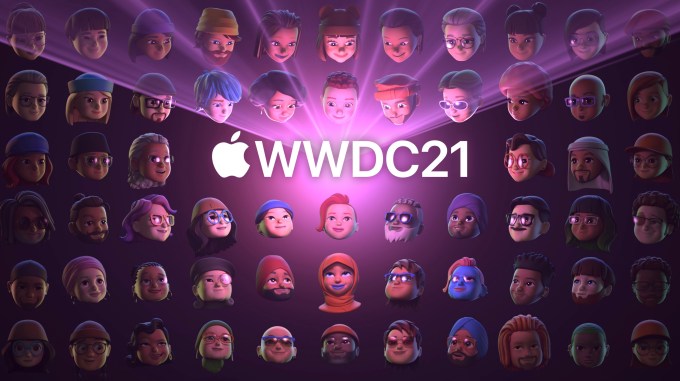
Image Credits: Apple
WWDC’s big keynote is kicking off next week on June 7 at 1 PM ET. The livestream page is here. While we may see new MacBook Pros, what software developers will care about are the forthcoming details about Apple’s latest OS releases and other new technologies. As to what they may include? Bloomberg reported that iOS 15 will introduce a way for users to set different notification preferences and automatic replies, based on their current status (driving, working, sleeping, etc.) and an updated Lock Screen where this menu of choices would be accessible. iMessage may be upgraded to be more social, to better compete with Messenger and WhatsApp. Meanwhile, iPadOS could be getting the App Library and an upgraded Home Screen with support for widgets. (And you can fill the screen with just widgets, if you choose.) Or who knows! Until it’s official, it’s all a maybe!
But one potentially interesting rumor to watch for would be a new privacy feature that would show users which apps were collecting data about them. This builds on Apple’s investments in App Tracking Transparency and could make it more difficult for shady SDKs to stay in business.
There will likely be some updates coming to other Apple’s own apps, Siri, watchOS and more. It’s going to be a packed week — stay tuned!
Ahead of WWDC, Apple also updated its report (conducted on its behalf via the Analysis Group) on App Store commerce. The company says the App Store facilitated $643 billion in billings and sales in 2020, up 24% from the $519 billion seen the year prior. It also noted that about 90% of the billings and sales facilitated by the App Store actually took place outside its walls, meaning Apple took no commission on those purchases. This is up from the 85% figure reported last year. The full report delves into other trends related to the pandemic’s impact, small and large businesses, and more. Apple initially commissioned the report to demonstrate how little business on the App Store is actually subject to App Store fees, but now it’s updated the report a year later. It’s interesting how much understanding Apple has about its App Store, especially when Tim Cook claimed to know so little about several crucial figures.
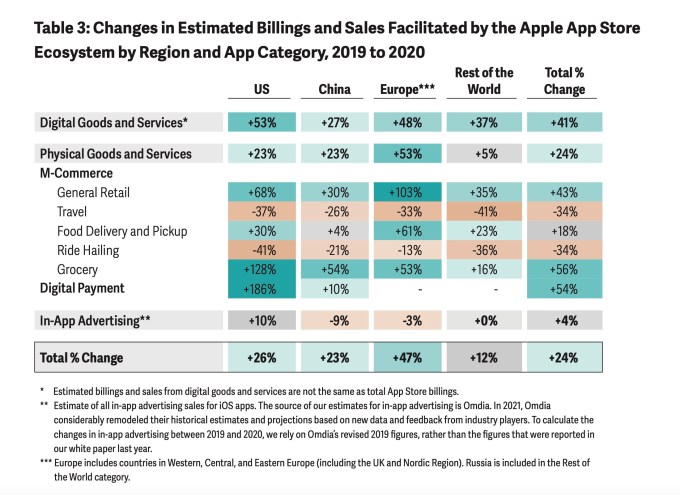
Image Credits: Apple
Apple also this week unveiled its 2021 Apple Design finalists. The awards honor apps and games that offer a combination of innovation, ingenuity and technical achievement — the latter which often means making great use of Apple technologies. The finalists span six categories: Inclusivity, Delight and Fun, Interaction, Social Impact, Visuals and Graphics, and Innovation.
Among the prospective winners are apps including snarky weather app Carrot Weather as well as the unique (Not Boring) Weather, short-form news service Brief, mental wellness app and Google Play award winner Loona, Editor’s Choice Genshin Impact, Snowman’s new kids app Pok Pok Playroom and summertime fun music app Poolside FM, and many others.
Google this week opened submissions for two of its annual developer programs: the Indie Games Accelerator and the Indie Games Festival. The programs are designed to help small games studios grow on Google Play. This year, the programs will include more eligible markets and will be fully digital experiences.
Google will restrict third-party apps from customizing the native Android Sharesheet in Android 12. Currently, the UI of the Sharesheet can differ from app to app, but XDA Developers reports it will become more iOS-like, by offering a consistent menu across apps.
Google is taking a cue from Apple by allowing users to opt out of personalization using the advertising ID in the Android Settings. Once users opt out, the advertising ID is disabled. The ID is a unique, user-resettable identifier provided by Google Play services. As part of a coming Google Play services update in late 2021, the advertising identifier will be removed when the user opts out of tracking, and any attempt to access the identifier will only return a string of zeros. Google says ad and analytics service partners will receive notifications about a user’s preferences to help them with compliance. The change will roll out in late 2021 and will impact apps running on Android 12 devices initially, with an expansion to devices that support Google Play in early 2022.

Image Credits: Wang Chenglu, president of Huawei Consumer Business Group’s software department
Two years after Huawei was put on a list of Chinese companies banned from doing business with U.S. organizations, it launched its proprietary operating system, HarmonyOS, for smartphones. The OS is designed to power phones, tablets and smart devices. Smartphone maker Meizu has already hinted it may adopt the new OS.

Image Credits: Facebook
Facebook’s flagship AR creation software, Spark AR, has already been used by more than 600,000 creators from over 190 countries to publish over 2 million AR effects. At Facebook’s F8 event this week, the company announced Multipeer API for video calls on Messenger, Instagram and Portal. The API will allow developers to create “shared AR” effects that apply to all the call participants — like a party hat that shows up on everyone’s heads for a birthday call, for instance.
Convenience store-style on-demand delivery startup JOKR launched in New York City to provide 15-minute or less delivery of items you might otherwise find in small stores and local delis. Except instead of dealing with stores, JOKR has its own strategically placed micro-hubs. The startup was founded by Ralf Wenzel, who previously founded Foodpanda, which later merged with Delivery Hero.

Image Credits: Walmart
Walmart is handing out over 740,000 new Samsung Galaxy XCover Pro smartphones (retail $499) to its employees, saying that “constant communication” is essential to its business. The phones will run Walmart’s proprietary Me@Walmart app, where employees clock in, adjust schedules, use the voice assistant “Ask Sam,” and communicate with others via push-to-talk. Employees will be allowed to use the phone for personal use after work hours, and Walmart will not have access to their personal data, the retailer says.
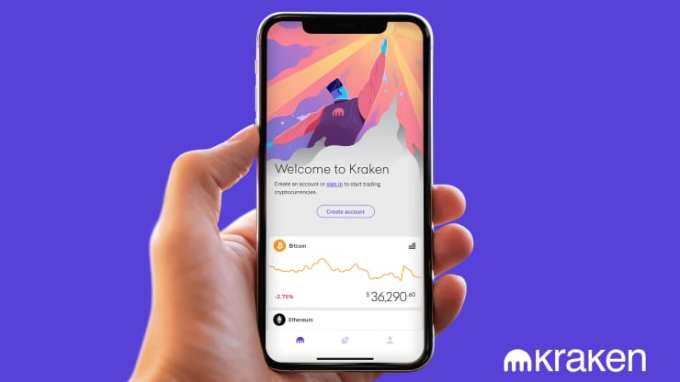
Image Credits: Kraken
Coinbase rival Kraken launched a mobile app in the U.S. that allows users to buy and sell more than 50 crypto tokens from their mobile phone. Kraken is the world’s fourth-largest digital currency exchange, in terms of trading volume.
Venmo now lets users hide their friend list for additional privacy. The change to the app came after BuzzFeed News found President Biden’s Venmo account using public friend lists. Digital rights groups had called the design a “security nightmare.”
Japan-based Line Corp. is launching its digital banking platform in Indonesia, which means it will now offering banking services in three of its biggest overseas markets: Indonesia, Thailand and Taiwan.
Coinbase Card, which allows users to spend their crypto while on the go, now works with Apple Pay and Google Pay. The card will offer up to 4% in crypto rewards for everyday purchases.
Chime has established itself as the No. 1 neobank in the U.S., according to eMarketer. The banking app will have 13.1 million U.S. accounts this year, up 30.7% from 2020. Current will have 4 million, double from the 2.1 million it had last year. Aspiration is in third place, with 3 million, followed by Varo, at 2.7 million.
 Scoop: Tinder tested a group video chat feature ahead of parent company Match’s move into social discovery with its $1.73 billion acquisition of Seoul-based Hyperconnect. The feature was only tested briefly in New Zealand and then shut down, but may have served as a way to gain valuable data about younger users’ interest in social discovery apps and services as Match moves into that market which it says is double the size of the dating market.
Scoop: Tinder tested a group video chat feature ahead of parent company Match’s move into social discovery with its $1.73 billion acquisition of Seoul-based Hyperconnect. The feature was only tested briefly in New Zealand and then shut down, but may have served as a way to gain valuable data about younger users’ interest in social discovery apps and services as Match moves into that market which it says is double the size of the dating market.
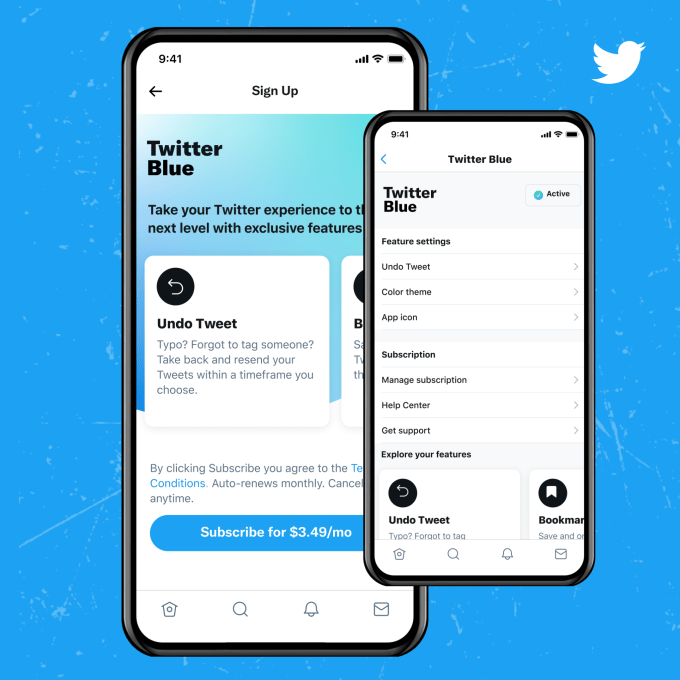
Image Credits: Twitter
Twitter Blue officially launched. Will you pay for better Twitter? Twitter’s new premium subscription brings tools to organize your bookmarks, read threads in a clutter-free format and take advantage of an “Undo Tweet” feature — which is the closest thing Twitter will have to the long-requested “Edit” button. It also offers a few other perks, like custom app icons, colorful themes and subscription customer support. Unfortunately, the service is only live in Canada and Australia for the time being.
Twitter redesigned its mobile app to put its Clubhouse rival, Twitter Spaces, in the middle of its navigation bar. Initially, only around 500 people from the original Spaces beta test will first see the new Spaces discovery tab, but it will expand to more people over time. The tab will help people keep track of Spaces they want to listen to and manage notifications, among other things.
Twitter began rolling out Birdwatch fact checks inside tweets. Birdwatch is Twitter’s pilot program that aims to crowdsource fact-checking of tweets, as an alternative to relying on fact-checkers. The program’s goal will be to append more info to misinformation online in real time.
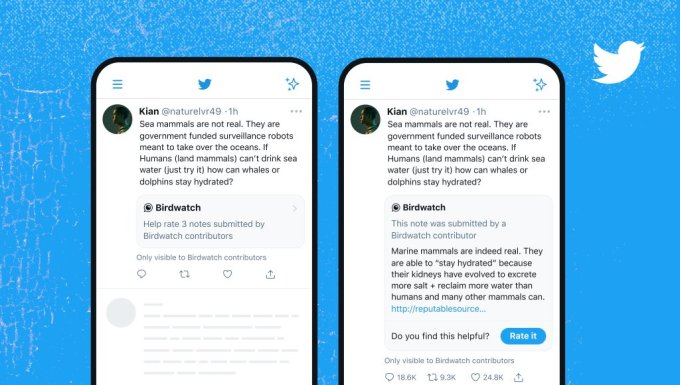
TikTok reamined the top non-game app worldwide in May 2021 by downloads. According to Sensor Tower, TikTok was No. 1 on both the App Store and Google Play with 80 million combined installs. Brazil accounted for 16% of those, and China 12%.
Facebook at its developer conference F8 also introduced Facebook Login Connect with Messenger. For businesses that have already integrated with Facebook Login, this allow users to log in to their app using their Facebook credentials and opt in to chat with businesses over Messenger, all in the Facebook Login flow. The tool is in closed beta.
Facebook also updated its Business Suite with a new feature that will allow developers to build “business apps,” which are tools made by third-party developers that work alongside the Business Suite. These “apps” could do things like bring in content from a catalog to their Facebook page or Instagram account. The platform already has 30 developers working on it and integrates with e-commerce platforms, like BigCommerce.

Image Credits: Facebook
WhatsApp reversed course and now says it won’t reduce the app’s functionality if users don’t agree to its new privacy policy. The rollout had led to a lot of backlash as it revealed the messaging app would begin sharing more info with Facebook.
As part of its F8-related announcements, WhatsApp said it would update its Business API to make it quicker for business to get started with its service. WhatsApp will make it faster to set up a business account (5 minutes instead of weeks), and will allow businesses to respond faster to inbound messages, as well as send messages to users who opted in. The business tool for customer care will allow up to 10 pre-written messages, among other updates.
Facebook CEO Mark Zuckerberg told popular news outlet/leaker WaBetaInfo that WhatsApp will add multi-device support for connecting up to four devices to one account. He also said WhatsApp will introduce a “view once” disappearing feature for photos and videos, and is working on an iPad app. The method of delivering this news is worth noting — WaBetaInfo is not a traditional news outlet, but more of an independent news portal of sorts. Zuckerberg has been taking Facebook news to non-traditional (and often far friendlier) channels as of late, including popping up in Clubhouse rooms and other independent outlets. Facebook clearly feels mainstream press has turned on it when they…[checks notes]…held Facebook accountable for its actions.
Facebook also announced the general availability of the Messenger API for Instagram. First announced last fall and rolling out in phases, the API offers a more efficient way for larger brands to handle a high volume of messages by allowing them to integrate Instagram messaging into the tools and applications they’re already using in-house to manage their Facebook conversations.
Community social network Nextdoor launched a new feature called Free Finds that helps its users unload their unwanted stuff on others in their neighborhood. Notably, the feature doesn’t require you to be a Nextdoor member to access the listings, but eventually, those users may convert.

Image Credits: Spotify
Spotify rolled out a sort of mid-year version of Wrapped with the launch of the new personalized experience, Only You. The feature offers insights about your music history in a sharable format, like your musical dinner party or audio birth chart, and other fun finds. Why now? Perhaps Spotify is heading off Apple Music news to come with a feature that reminds users it does personalization best?
Spotify also added Blend, a way to create a playlist with any other Spotify user. The company offers a similar feature for users on its Family and Duo plans, but this new tool doesn’t require users to be in the same household.
Apple tried to acquire livestreaming music platform Verzuz, which later sold to video social network Triller, Bloomberg reported. Apple didn’t engage in a bidding war and offered a lower price than what Triller paid, it said.
The Apple TV app launched on Android devices. Like Apple Music, Apple TV is a service that needs to work across platforms in order to compete with rivals. The Android app’s arrival followed the Apple TV app’s debut on Nvidia’s Shield TV, which means it’s now available across all major Android TV-based devices.
Amazon updated its Halo health app with a new feature called Movement Health, which will use computer vision and machine learning to asses users’ posture, mobility and stability and then suggest exercises to improve them.
Peloton slashed the pricing for its fitness app, normally $12.99/mo, for students, teachers, healthcare workers and military. Students can pay $6.99/mo while the others can pay $9.99/mo. Military members and their families can lock in that rate for life. The company is facing a PR crisis after recalling treadmills that injured 70 and led to one infant death.
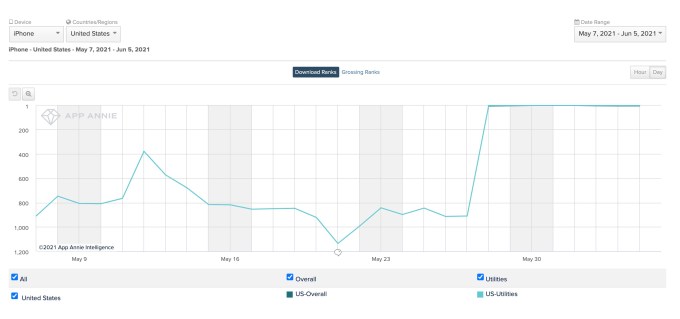
Image Credits: App Annie
A TikTok trend where users prank people by spamming them on text has driven the app that makes that possible, Paste Keyboard, to the top of the App Store. Mashable noted the app’s rise, but couldn’t figure out why. Nor could App Annie. It’s kids, y’all. Honestly, the App Store needs a new “viral” chart at this point.
AirTag support is coming to Android. Apple announced some changes to AirTag, including the period of time they’ll make a sound when moved. The time will change from three times per day to a random time between 8-24 hours. Apple believes the shortening of the window will serve as a better deterrent against bad actors using AirTag to track someone. Alongside this announcement, Apple said it will later this year launch an Android application that will allow users to detect AirTag or other Find My network-enabled accessories that are separated from its owner and may be traveling with a user.
Firefox revamped its Mac and iOS app this week with a what it claims is a more distraction-free design, featuring streamlined toolbar and menus, expanded privacy protections, a new look for tabs, updated notifications and alerts, easier muting, and more.
Ring added “Request for Assistance posts” on its Neighbors app, claiming this will allow public safety agencies (e.g. police) to ask communities for help in investigations. The Request for Assistance posts can only be issued from verified public safety agency profiles, Ring says. Of course, this isn’t the only way police can acquire Ring videos, as the company has many police partnerships across the U.S. that let them acquire footage without a warrant.
Toyota added a data privacy portal to its apps. The feature is available in the Account Settings of the Toyota and Lexus apps and works with vehicles offering connected services that were built in the 2013 model year or later. It also allows consumers who own multiple Toyota or Lexus vehicles to customize privacy and data-sharing settings for each.
Gokada is launching its ride-hailing service in two more Nigerian cities as part of its super app plans. The company is merging its ride-hailing service with food delivery platform GShop. In the past year, Gokada crossed $100 million in annualized transaction value, and helped onboard 30,000 merchants.
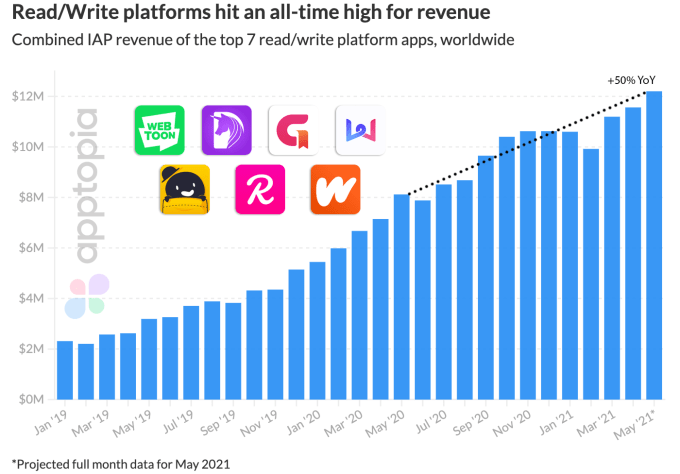
Image Credits: Apptopia
The top reading and writing apps grew their IAP revenue 50% YoY in May 2021, Apptopia reported. This group includes apps for writing novels or comic books, or reading the works from others, like Webtoon, Wattpad, Dreame, GoodNovel, Webnovel, Tapas and Radish. As a grouping, these apps have also grown IAP revenue 15% over the past six months. Since January 2020, Webtoon and Dreame combined accounted for 56.3% of the grouping’s total IAP revenue.
Google, Facebook, WhatsApp, Telegram, LinkedIn and startups ShareChat and Koo have now either fully or partially complied with India’s IT rules that require them to appoint and share contact details of representatives tasked with compliance, nodal point of reference and grievance redressals to address on-ground concerns. Twitter, whose offices were raided by police in Delhi, has not yet complied.
EU will review TikTok’s Terms of Service following child safety complaints. Areas of concern include hidden marketing, aggressive advertising techniques targeted at children and contractual terms in the company’s policies that could be misleading or confusing for consumers.
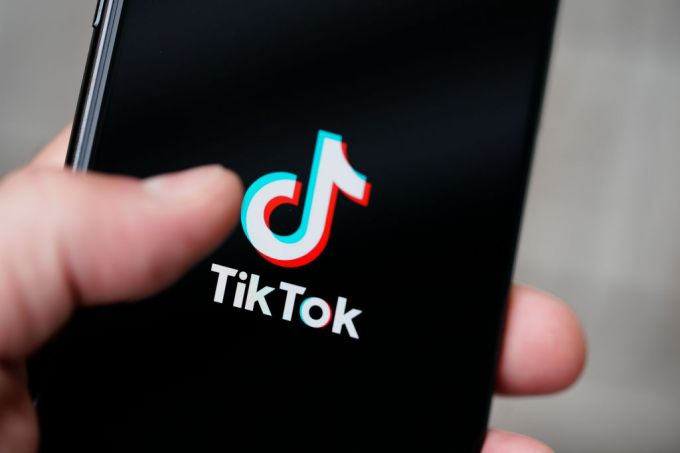
The TikTok logo is seen on an iPhone 11 Pro max
 Scoop: TikTok just gave itself permission to collect biometric data on U.S. users, including “faceprints and voiceprints.” A change to TikTok’s U.S. privacy policy on Wednesday introduced a new section that says the social video app “may collect biometric identifiers and biometric information” from its users’ content, including things like “faceprints and voiceprints.” Reached for comment, TikTok could not confirm what product developments necessitated the addition of biometric data to its list of disclosures about the information it automatically collects from users, but said it would ask for consent in the case such data collection practices began.
Scoop: TikTok just gave itself permission to collect biometric data on U.S. users, including “faceprints and voiceprints.” A change to TikTok’s U.S. privacy policy on Wednesday introduced a new section that says the social video app “may collect biometric identifiers and biometric information” from its users’ content, including things like “faceprints and voiceprints.” Reached for comment, TikTok could not confirm what product developments necessitated the addition of biometric data to its list of disclosures about the information it automatically collects from users, but said it would ask for consent in the case such data collection practices began.
The biometric data collection details were introduced in the newly added section, “Image and Audio Information,” found under the heading of “Information we collect automatically” in the policy.
Alibaba’s UC Browser app has been found to be harvesting the private web activity of users across Android or iOS when incognito mode is turned on. The browser is the fourth largest in the world, with 500 million Android downloads alone. Before being banned in India over security concerns related to Chinese apps, it was also one of the most popular in India, as well.
 Miami-based NUE Life Health raised $3.3 million for its telemedicine platform and app in the U.S., where it combines mental wellness solutions that employ psychedelic-assisted therapies with a graph database-driven app. The app was backed by investors who recently left SV for Miami, including Jack Abraham, Shervin Pishevar, Martin Varsavsky, Jon Oringer, James Bailey and Christina Getty.
Miami-based NUE Life Health raised $3.3 million for its telemedicine platform and app in the U.S., where it combines mental wellness solutions that employ psychedelic-assisted therapies with a graph database-driven app. The app was backed by investors who recently left SV for Miami, including Jack Abraham, Shervin Pishevar, Martin Varsavsky, Jon Oringer, James Bailey and Christina Getty.
 Etsy acquired secondhand e-commerce startup Depop for more than $1.6 billion. Depop, which caters to a Gen Z crowd, saw 2020 gross merchandise sales and revenue of approximately $650 million and $70 million, respectively.
Etsy acquired secondhand e-commerce startup Depop for more than $1.6 billion. Depop, which caters to a Gen Z crowd, saw 2020 gross merchandise sales and revenue of approximately $650 million and $70 million, respectively.
 Social network platform Venn raised $60 million in Series B funding led by Group 11. The startup provides technology that allows building owners and other real estate partners and communities to provide social networking services to their tenants, with tools for organizing buy/sell groups, organizing community activities, connecting with neighbors and more.
Social network platform Venn raised $60 million in Series B funding led by Group 11. The startup provides technology that allows building owners and other real estate partners and communities to provide social networking services to their tenants, with tools for organizing buy/sell groups, organizing community activities, connecting with neighbors and more.
 Digital health management company Hello Heart raised $45 million Series C led by IVP. The company’s app is marketed by employers as part of their benefit programs and helps patients manage heart health and blood pressure, medications and more.
Digital health management company Hello Heart raised $45 million Series C led by IVP. The company’s app is marketed by employers as part of their benefit programs and helps patients manage heart health and blood pressure, medications and more.
 Personal finance app Truebill raised $17 million in Series C funding led by Accel, valuing the business at $500 million. The app helps consumers get better control over their finances by helping them cancel subscriptions, negotiate bills, view credit reports, budget, and access spending insights, among other things.
Personal finance app Truebill raised $17 million in Series C funding led by Accel, valuing the business at $500 million. The app helps consumers get better control over their finances by helping them cancel subscriptions, negotiate bills, view credit reports, budget, and access spending insights, among other things.
 Newly launched stock trading app Lightyear disclosed it raised $1.5 million pre-seed funding in a round co-led by the new unnamed fund formed by Wise co-founder Taavet Hinrikus and Teleport co-founder Sten Tamkivi. The app was the fund’s first investment.
Newly launched stock trading app Lightyear disclosed it raised $1.5 million pre-seed funding in a round co-led by the new unnamed fund formed by Wise co-founder Taavet Hinrikus and Teleport co-founder Sten Tamkivi. The app was the fund’s first investment.
 Istanbul-based grocery delivery app Getir raised $550 million in new funding, tripling its valuation to $7.5 billion. New investors include DisruptAD and Mubadala Funding Firm (both being arms of Abu Dhabi sovereign wealth funds) as well as Silicon Valley-based Silver Lake.
Istanbul-based grocery delivery app Getir raised $550 million in new funding, tripling its valuation to $7.5 billion. New investors include DisruptAD and Mubadala Funding Firm (both being arms of Abu Dhabi sovereign wealth funds) as well as Silicon Valley-based Silver Lake.
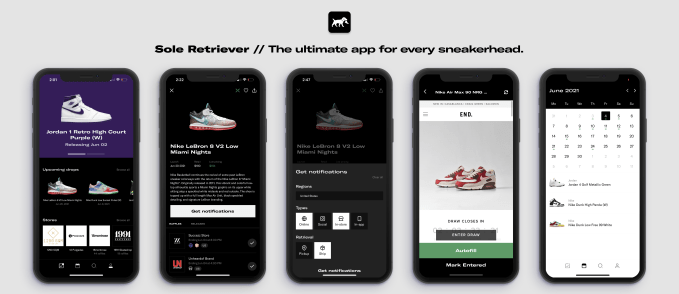
Image Credits: Sole Retriever
Sole Retriever is a newly launched app that aims to be a sneakerhead’s dream.
The app offers a one-stop shop for all things sneaker — including sneaker news, sneaker releases, sneaker raffles, a calendar of upcoming drops and more. The company says its goal is to democratize access to sneaker drops by making this info more accessible and convenient for consumers. Before its mobile launch, Sole Retriever had offered its service via the web only. Now it’s live on both iOS and Android.
Unique to the mobile experience is the ability to customize your alerts so you only hear about the raffles you want to know about — like those in the U.S., or only those that are in-store or online, for example. It also makes entering raffles easier with autofill features. Custom profiles that let you save the info for others who have agreed to let you enter their name and address to increase your chances of winning. And the app can save your logins for different retailers to make shopping easier.
Sole Retriever is currently only available as a waitlist, but TechCrunch readers can bypass the waitlist! Here’s how!
After downloading the app and logging in, when you reach the waitlist screen, you can redeem a special code — “TWIA” (in all caps!), which lets you bypass the entire waitlist and gain instant access to start your seven-day free trial for the app. The code is only valid for 24 hours after this post goes live so hit it quickly!
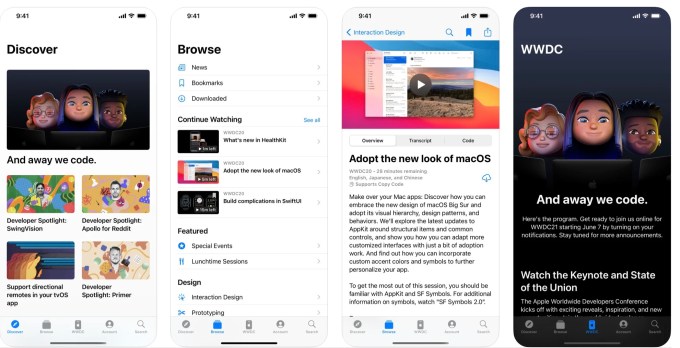
Image Credits: Apple
The Apple Developer app is not new. But it is the must-have download for the week ahead, as it will provide mobile developers with access to everything needed to navigate WWDC 21’s all-digital event. The app was updated this week with details about the agenda, sessions, pavilions, labs, coding and design challenges, and more. Developers can also sign up for labs inside the app and get notifications about their appointments. There are also new WWDC 21 iMessage stickers for some added fun.
Powered by WPeMatico
Prospective contributors regularly ask us about which topics Extra Crunch subscribers would like to hear more about, and the answer is always the same:
Our submission guidelines haven’t changed, but Managing Editor Eric Eldon and I wrote a short post that identifies the topics we’re prioritizing at the moment:
If you’re a skillful entrepreneur, founder or investor who’s interested in helping someone else build their business, please read our latest guidelines, then send your ideas to guestcolumns@techcrunch.com.
Thanks for reading; I hope you have a great weekend.
Walter Thompson
Senior Editor, TechCrunch
@yourprotagonist
Full Extra Crunch articles are only available to members
Use discount code ECFriday to save 20% off a one- or two-year subscription

Image Credits: olegkalina (opens in a new window) / Getty Images
Debt is a tool, and like any other — be it a hammer or handsaw — it’s extremely valuable when used skillfully but can cause a lot of pain when mismanaged. This is a story about how it can go right.
Mario Ciabarra, the founder and CEO of Quantum Metric, breaks down how his company was on a “tremendous growth curve” — and then the pandemic hit.
“As the weeks following the initial shelter-in-place orders ticked by, the rush toward digital grew exponentially, and opportunities to secure new customers started piling up,” Ciabarra writes. “A solution to our money problems, perhaps? Not so fast — it was a classic case of needing to spend in order to make.”
If companies want to preserve equity, debt can be an advantageous choice. Here’s how Quantum Metric did it.

Image Credits: mucahiddin / Getty Images
People have been working to optimize customer experiences (CX) since we began selling things to each other.
A famous San Francisco bakery has an exhaust fan at street level; each morning, its neighbors awake to the scent of orange-cinnamon morning buns wafting down the block. Similarly, savvy hairstylists know to greet returning customers by asking if they want a repeat or something new.
Online, CX may encompass anything from recommending the right shoes to AI that knows when to send a frustrated traveler an upgrade for a delayed flight.
In light of Qualtrics’ spinout and IPO and Sprinklr’s recent S-1, Rebecca Liu-Doyle, principal at Insight Partners, describes four key attributes shared by “companies that have upped their CX game.”

Image Credits: We Are (opens in a new window) / Getty Images
What is a microblogging service doing buying a social podcasting company and a newsletter tool while also building a live broadcasting sub-app? Is there even a strategy at all?
Yes. Twitter is trying to revitalize itself by adding more contexts for discourse to its repertoire. The result, if everything goes right, will be an influence superapp that hasn’t existed anywhere before. The alternative is nothing less than the destruction of Twitter into a link-forwarding service.
Let’s talk about how Twitter is trying to eat the public conversation.

Image Credits: Nigel Sussman (opens in a new window)
Although it was a truncated holiday week here in the United States, there was a bushel of IPO news. We sorted through the updates and came up with a series of sentiment calls regarding these public offerings.
Earlier this week, we took a look at:

Image Credits: Nigel Sussman
Part 4 of Expensify’s EC-1 digs into the company’s engineering and technology, with Anna Heim noting that the group of P2P pirates/hackers set out to build an expense management app by sticking to their gut and making their own rules.
They asked questions few considered, like: Why have lots of employees when you can find a way to get work done and reach impressive profitability with a few? Why work from an office in San Francisco when the internet lets you work from anywhere, even a sailboat in the Caribbean?
It makes sense in a way: If you’re a pirate, to hell with the rules, right?
With that in mind, one could assume Expensify decided to ask itself: Why not build our own totally custom tech stack?
Indeed, Expensify has made several tech decisions that were met with disbelief, but its belief in its own choices has paid off over the years, and the company is ready to IPO any day now.
How much of a tech advantage Expensify enjoys owing to such choices is an open question, but one thing is clear: These choices are key to understanding Expensify and its roadmap. Let’s take a look.

Image Credits: Getty Images
The news this week that e-commerce marketplace Etsy will buy Depop, a startup that provides a secondhand e-commerce marketplace, for more than $1.6 billion may not have made a large impact on the acquiring company’s share price thus far, but it provides a fascinating look into what brands may be willing to pay for access to the Gen Z market.
Etsy is buying Gen Z love. Think about it — Gen Z is probably not the first demographic that comes to mind when you consider Etsy, so you can see why the deal may pencil out in the larger company’s mind.
But it isn’t cheap. The lesson from the Etsy-Depop deal appears to be that large e-commerce players are willing to splash out for youth-approved marketplaces. That’s good news for yet-private companies that are popular with the budding generation.

Image Credits: Andriy Onufriyenko / Getty Images
Confluent became the latest company to announce its intent to take the IPO route, officially filing its S-1 paperwork this week.
The company, which has raised over $455 million since it launched in 2014, was most recently valued at just over $4.5 billion when it raised $250 million last April.
What does Confluent do? It built a streaming data platform on top of the open-source Apache Kafka project. In addition to its open-source roots, Confluent has a free tier of its commercial cloud offering to complement its paid products, helping generate top-of-funnel inflows that it converts to sales.
What we can see in Confluent is nearly an old-school, high-burn SaaS business. It has taken on oodles of capital and used it in an increasingly expensive sales model.

Image Credits: Orla (opens in a new window) / Getty Images
Would you like to work with private equity and venture capital funds?
There are relatively few jobs directly inside private equity and venture capital funds, and those jobs are highly competitive.
However, there are many other ways you can work and earn money within the industry — as a consultant, an interim executive, a board member, a deal executive partnering to buy a company, an executive in residence or as an entrepreneur in residence.
Let’s take a look at the different ways you can work with the investment community.

Image Credits: Nigel Sussman (opens in a new window)
Even among the most valuable tech shops, shareholder return is concentrated in share price appreciation, and buybacks, which is the same thing to a degree.
Slowly growing tech companies worth single-digit billions can’t play the buyback game to the same degree as the majors. And they are growing more slowly, so even a similar buyback program in relative scale would excite less.
Grow or die, in other words. Or at least grow or come under heavy fire from external investors who want to oust the founder-CEO and “reform” the company. But if you can grow quickly, welcome to the land of milk and honey.
Even among the most valuable tech shops, shareholder return is concentrated in share price appreciation, and buybacks, which is the same thing to a degree.
Slowly growing tech companies worth single-digit billions can’t play the buyback game to the same degree as the majors. And they are growing more slowly, so even a similar buyback program in relative scale would excite less.
Grow or die, in other words. Or at least grow or come under heavy fire from external investors who want to oust the founder-CEO and “reform” the company. But if you can grow quickly, welcome to the land of milk and honey.

Image Credits: Carol Yepes (opens in a new window) / Getty Images
There is a growing group of entrepreneurs who are betting that hormonal health is the key wedge into the digital health boom.
Hormones are fluctuating, ever-evolving, and diverse — but these founders say they’re also key to solving many health conditions that disproportionately impact women, from diabetes to infertility to mental health challenges.
Many believe it’s that complexity that underscores the opportunity. Hormonal health sits at the center of conversations around personalized medicine and women’s health: By 2025, women’s health could be a $50 billion industry, and by 2026, digital health more broadly is estimated to hit $221 billion.
Still, as funding for women’s health startups drops and stigma continues to impact where venture dollars go, it’s unclear whether the sector will remain in its infancy or hit a true inflection point.

Image Credits: sorbetto (opens in a new window)/ Getty Images
Two years ago, founders of calendar assistant platform Reclaim were looking for a “mango” seed round — a boodle of cash large enough to help them transition from the prototype phase to staffing up for a public launch.
Although the team received offers, co-founder Henry Shapiro says the few that materialized were poor options, partially because Reclaim was still pre-product.
“So one summer morning, my co-founder and I sat down in his garage — where we’d been prototyping, pitching and iterating for the past year — and realized that as hard as it was, we would have to walk away entirely and do a full reset on our fundraising strategy,” he writes.
Shapiro shares what he learned from embracing failure and offers three conclusions “every founder should consider before they decide to go out and pitch investors.”

Image Credits: Kevin Schafer / Getty Images
Although software as a service has been thriving as a sector for years, it has gone into overdrive in the past year as businesses responded to the pandemic by speeding up the migration of important functions to the cloud, ActiveCampaign founder and CEO Jason VandeBoom writes in a guest column.
“We’ve all seen the news of SaaS startups raising large funding rounds, with deal sizes and valuations steadily climbing. But as tech industry watchers know only too well, large funding rounds and valuations are not foolproof indicators of sustainable growth and longevity.”
VandeBoom notes that to scale sustainably, SaaS startups need to “stand apart from the herd at every phase of development. Failure to do so means a poor outcome for founders and investors.”
“As a founder who pivoted from on-premise to SaaS back in 2016, I have focused on scaling my company (most recently crossing 145,000 customers) and in the process, learned quite a bit about making a mark,” VandeBoom writes. “Here is some advice on differentiation at the various stages in the life of a SaaS startup.”
Powered by WPeMatico
Facebook has been making plenty of one-off virtual reality studio acquisitions lately, but today the company announced that they’re buying something with wider ambitions — a Roblox-like game creation platform.
Facebook shared that they’re buying Unit 2 Games, which builds a platform called Crayta. Like some other platforms out there, it builds on top of the Unreal Engine and gives users a more simple creation interface teamed with discovery and community features. Crayta has cornered its own niche pushing monetization paths like Battle Pass seasons, giving the platform a more Fortnite-like vibe as well.
Unit 2 has been around for just over three years, and Crayta launched just last July. Its audience has likely been limited by the studio’s deal to exclusively launch on Google’s cloud-streaming platform Stadia, though it’s also available on the Epic Games Store as of March.
The title feels designed for the lightweight nature of cloud-gaming platforms, with users able to share access to games just by linking other users, and Facebook seems keen to use Crayta to push forward their own efforts in the gaming sphere.
“Crayta has maximized current cloud-streaming technology to make game creation more accessible and easy to use. We plan to integrate Crayta’s creation toolset into Facebook Gaming’s cloud platform to instantly deliver new experiences on Facebook,” Facebook Gaming VP Vivek Sharma wrote in an announcement post.
The entire team will be coming on as part of the acquisition, though financial terms of the deal weren’t shared.
Powered by WPeMatico